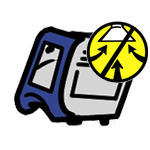
1- The primary cause of insufficient vacuum is due to system leaks. To confirm the vacuum pump is not generating sufficient vacuum, disconnect the pump from the application and test pump with a vacuum gauge. You can purchase a gauge here. Or, contact Chemtech Scientific to evaluate your pump free of charge.
2- Contamination/Dirty Pump - Diaphragm pump may acquire a buildup of process emissions over time, which may glaze the internal mechanisms and wetted pump parts with residual process emissions. When insufficient vacuum is accompanied by louder operating noise, the pump's performance may be improved with cleaning.
PTFE Diaphragm Pump Acetone Cleaning:
If the pump's specified ultimate vacuum is not reached anymore and the rest of the system has no leakage, the problem is often caused by stuck valve plates.
To clean them, proceed as follows:
- Remove all connections to the pump inlet and exhaust
- Place tubing on the exhaust of the pump to direct exhaust into a suitable container.
Switch the pump on.
NOTE - Use safety washing bottles to inject the acetone.
- Inject a small amount of about approx. 10 ml of acetone at once into the inlet side of the pump and wait until the pump makes the same sound as before injecting solvent.
- Repeat the injection step four to five times.
- Let the pump run for about 2 minutes and check whether the end vacuum can be reached.
- If the pump cannot be returned to near original specifications, repeat the cleaning procedure before going on with any disassembly work.
Contact Us for detailed cleaning, repair and maintenance instructions with illustrations.
3- Diaphragms are worn. Diaphragms are wear items on all diaphragm pumps. If the pump has over 5,000 hours of operation and suffers insufficient vacuum, worn membranes are the likely cause. Contact Us for detailed do it yourself repair guides for any brand of pump, or for service.
4- Failed diaphragm(s). A ruptured diaphragm will emit loud noises from the pump and be accompanied by insufficient vacuum. Contact Us for detailed do it yourself repair guides for any brand of pump, or for service.



